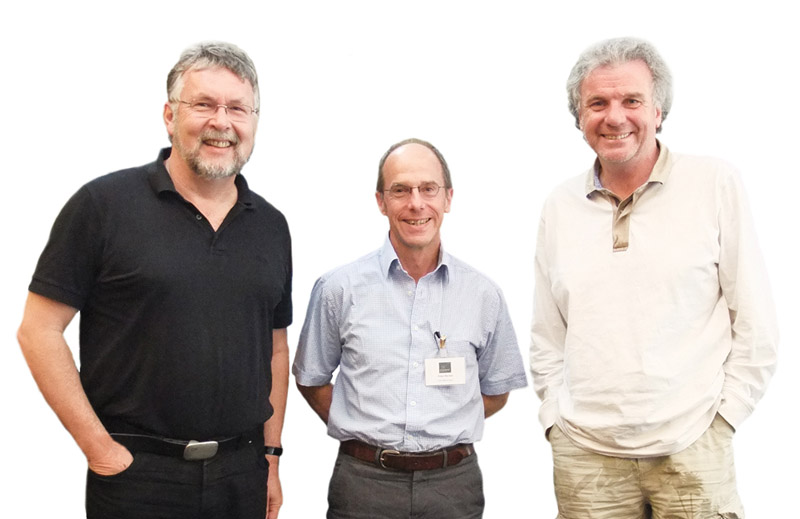Pluripotency project brings former group leaders back together

Trio celebrates two-decade collaboration
In 1990 Peter Becker, Hans Schöler and Francis Stewart were simultaneously recruited to EMBL as group leaders by the recently appointed Gene Expression Program Director, Iain Mattaj. At that time chromatin was emerging as a new, puzzling, component in the regulation of gene expression during metazoan development. The triple appointment aimed to strengthen, in one dramatic swoop, research activity in developmental and chromatin aspects of gene expression (now termed ‘epigenetics’). The swoop worked.
This time also corresponded with the emergence of embryonic stem cells and the beginnings of gene targeting technology. Each of the three erstwhile group leaders made the most of the opportunities at EMBL. Peter pioneered chromatin assembly in vitro and then characterized a molecular machine, ISWI, that pushes the fundamental component of chromatin, the nucleosome, around. Hans pioneered the basics of embryonic stem cell biology largely through his identification and characterization of the key pluripotency transcription factor, which is central to mammalian development. Francis pioneered genome engineering technologies including ligand inducible genetic recombination and the expertise that is now termed ‘recombineering’. He also identified the first protein complex that methylates nucleosomes on histone 3 lysine 4, which is now recognized as the most important post-translational modification of the nucleosome.
As always at EMBL, Biological Time was ticking. Not because the three amigos would run out of oocytes, in fact Hans later managed to derive them in culture, but the EMBL 9-year rule intervened, and it was time to move on.
From group leader at EMBL to Professor is an epigenetic flip in career terms, and it took the three amigos in different directions. Hans went to Philadelphia, Peter to Munich and Francis the Aussie joined the Moses of EMBL, Kai Simons, in his trek across Germany to the land of the Ossies.
In 2004, Hans returned to Germany to become director of the newly founded Max Planck Institute for Molecular Biomedicine, in Münster. Peter complemented his ongoing research accomplishments as central manager for planning and execution of the largest research building in Germany. The Biomedical Center Munich on the Martinsried campus will host eight large medical research units cooperating on the overarching topic of ‘Plasticity of cellular programmes’. Francis has been part of the Kai Simons inner sanctum that has transformed Dresden to a leading position in European biomedical research, including acquisition of €85 million for the Center for Regenerative Therapies and elite university status.
A happy recombination event occurred when each of the three had research proposals approved for SPP1356 ‘Pluripotency and Cellular Reprogramming’. Led by Albrecht Müller, of Würzburg University, the pluripotency project has brought together experts in stem cell biology and the regulation of gene expression. The three alumni were recently reunited at the SPP1356 annual meeting at Veithochsheim.
Increasingly, the contacts made at EMBL provide a shared understanding that can lead to ongoing scientific collaboration. The other colleagues that shared work at EMBL have all contributed to an ongoing common understanding-Matthias Mann, Bertrand Seraphin, Henk Stunnenberg, Thomas Graf, Luis Serrano, Juan de Valcarcel, Elisa Izzuaralde, Ernst Stelzer and Angus Lamond, to name just a few, all contributed and are still collaborating to define the regulatory interactions of differential gene expression and how pluripotency is established in the embryo, maintained in embryonic stem cells and reestablished by cellular reprogramming.
The combined work on sorting out the puzzle has continued beyond the boundaries of EMBL Heidelberg, with each of the three colleagues collaborating extensively with international associates, but still owes much to the early inspiration of the Gene Expression Program headed by Iain Mattaj, and the decisive leadership of Director-General Lenard Phillipson which allowed the study of gene expression to become a central focus of European biological research.
After their formative years at EMBL, the former group leaders have each become internationally prominent in their fields. New advances in technology and old ties of friendship may well see them collaborating again in deciphering the epigenetic codes of differentiation and pluripotency.
Michelle Meredyth-Stewart